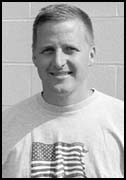 Ever since he started as an Air Force navigator, Captain Chad Christopherson has been spending a third of his time patrolling the Balkans. During the recent NATO air war against Serbia, he might have accomplished his last assignment to the region.
Ever since he started as an Air Force navigator, Captain Chad Christopherson has been spending a third of his time patrolling the Balkans. During the recent NATO air war against Serbia, he might have accomplished his last assignment to the region.Since 1996, Christopherson has been the navigator of a four-person flight crew on an EC-130E plane. Originally designed for transport, the seven planes in Christopherson's squadron have been modified for command and control. Up front, the crew--consisting of a pilot, co-pilot, navigator, and engineer--fly the plane, while in back a group of about 13 sits at the consoles of a 20,000-lb. computer and talks by radio to the command center back in Italy and to incoming war planes.
The 42nd Airborne Command and Control Center started operations out of Italy in 1993, coordinating airborne missions over Bosnia at that time. Each crew would complete about three missions each year to Italy, spending around 150 days per year.
Their assignment over Bosnia was being scaled down when the trouble in Kosovo started. "Once Kosovo started, we went to five crews," said Christopherson. "Basically, we were flying 24 hours (per day)."
Before the start of the air war, only two planes from Christopherson's squadron were in Italy. Three more planes were brought from their home base (Davis-Monthan Air Force Base in Tucson, Ariz.) to Italy. Christopherson and his crew mates flew one plane across the Atlantic Ocean, which required three days and stops on the East Coast and on a Portuguese Island.
During the action, the command plane would maintain radio contact between aircraft and the base back in Italy to clear targets for the planes. "We don't drop bombs at all," said Christopherson. "We're totally support."
Christopherson said the inadvertent bombing of the Chinese Embassy was due to an inaccurate map, and that the target was cleared through all the channels.
Because the command plane is defenseless and it normally carries 17 plus a huge computer, it stays away from danger. "We fly out of all known threat range," said Christopherson.
During the Kosovo mission, the plane would leave Aviano Air Base in northern Italy and fly for 90 minutes to the coast of Albania. Then the flight crew would put the plane in a holding pattern, using autopilot, while the command crew in the back would coordinate incoming "packages" of war planes.
The EC-130E planes, which were built in the 1960s, can hold 10 hours worth of fuel. On most missions in Kosovo, the plane would refuel in the air, and missions would typically last around 13 hours. "It's more dangerous than flying in the clear blue sky," said Christopherson, of refueling while airborne. "Whenever you get two airplanes together, there's some danger, but we've never had any problems."
The five crews in Italy rotated duty. At the start that meant flying every other day, and Christopherson got used to night duty. "It wasn't too bad when you stay on the same schedule," he said.
Part of the way through the mission, Christopherson's squadron took on the additional task of training exercises with the Army's Apache helicopters in Albania. Extra flights were needed for that training, even though the Apaches were not used in combat.
On board the plane, Christopherson's responsibilities are to monitor the weather, the autopilot, and the time and distance of the plane, in order to meet the refueling plane, for instance. "I basically manipulate a computer to do what we want the plane to do," he said.
Christopherson's crew was stationed in Italy from the first week in May until the end of June. They originally were scheduled to return to the states on July 10, but with the cessation of the air offensive they were sent home earlier. His crew flew a plane home again, and the landing in Tucson was covered by local media there.
His squadron, which had served in the Balkans since 1993, is now home in Arizona.
During the Kosovo mission, a New York Times reporter flew with Christopherson's crew on some night missions and wrote an article that appeared in the June 3 edition.
Christopherson felt the military had accomplished their mission in Kosovo. "We were told to do something and we did it," he said. "I think with what we were given we did a good job."
From the air, he didn't see the bombs, the targets, or the refugees. Ground troops, he said, would have a totally different perspective. "I think everybody wishes that it wouldn't have come down to what it did," he added. "It's good that (the refugees) can go home."
Christopherson graduated from Paynesville High School and South Dakota State University before joining the Air Force through the Reserve Officer's Training Corps. He spent two years on an administrative assignment at Okinawa before being accepted to navigator school. He and his wife, Sandi (McCoy), also a Paynesville native, live in Tucson with their three children.
(Editors note: First Lieutenant Brad Fenske, a military intelligence officer in the Army, has arrived in Kosovo as part of the peacekeeping mission. He is stationed in the camp that is being set up and could spend five months there before returning to his base in Germany.)